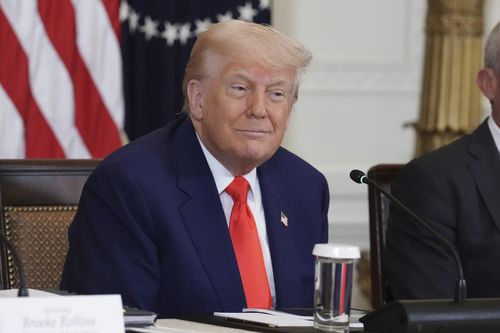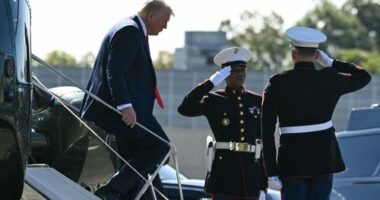Share this @internewscast.com

Trump was upset by the lack of progress in trade talks with the EU, which has proposed mutually cutting tariffs to zero even as the president has publicly insisted on preserving a baseline 10 per cent tax on most imports.
“Our discussions with them are going nowhere!” Trump posted on Truth Social.
“Therefore, I am recommending a straight 50 per cent Tariff on the European Union, starting on June 1, 2025. There is no Tariff if the product is built or manufactured in the United States.”
That post had been preceded by a threat of import taxes against Apple for its plans to continue making its iPhone in Asia.
Apple now joins Amazon, Walmart and other major US companies in the White House’s crosshairs as they try to respond to the uncertainty and inflationary pressures unleashed by his tariffs.

“I have long ago informed Tim Cook of Apple that I expect their iPhone’s that will be sold in the United States of America will be manufactured and built in the United States, not India, or anyplace else,” Trump wrote.
“If that is not the case, a Tariff of at least 25 per cent must be paid by Apple to the US.”
In response to Trump’s tariffs on China, Apple CEO Tim Cook said earlier this month that most iPhones solid in the US during the current fiscal quarter would come from India, with iPads and other devices being imported from Vietnam.
After Trump rolled out tariffs in April, bank analysts estimated that a $US1200 ($1859) iPhone would, if made in America, jump in price anywhere from $US1500 to $US3500 ($2325 – $5425).
Stocks sold off after Trump’s postings, with the S&P 500 index down roughly 0.5 per cent in early Friday afternoon trading.
The markets have developed a hair trigger sensitivity to the US president’s statements, often slumping when he announces high tariffs and rallying when he retreats from those threats.

US Treasury Secretary Scott Bessent tried to provide some clarity on Trump’s postings in a Friday interview on the Fox News show America’s Newsroom.
Bessent said the EU has a “collective action problem” because its 27 member states are being represented by “this one group in Brussels,” such that the “underlying countries don’t even know what the EU is negotiating on their behalf.”
The Treasury secretary said he was not in a White House meeting this week that Cook attended, but he also spoke with the Apple CEO this week. Bessent said the goal was to have Apple bring more of its computer chip supply chain into the US.
The core of Trump’s argument against the EU is that America runs a “totally unacceptable” trade deficit with the 27 member states. Countries run trade deficits when they import more goods than they export.
From the vantage point of the EU’s executive commission, trade with the US is roughly in balance if both goods and services are included. As a global centre for finance and technology, the US runs a trade surplus in services with Europe. That offsets some of the trade gap in goods and puts the imbalance at â¬48 billion ($84.2 billion).
German Foreign Minister Johann Wadephul said the EU’s executive commission has his country’s full support in working to “preserve our access to the American market”.
“I think such tariffs help no one, but would just lead to economic development in both markets suffering,” Wadephul said in Berlin.
“So we are still counting on negotiations, and support the European Commission in defending Europe and the European market while at the same time working on persuasion in America.”
Trump aides have said the goal of his tariffs was to isolate China and strike new agreements with allies, but the president’s tariff threats undermine the logic of those claims.
Not only could the EU face higher tariffs than China, but the bloc of member states might have been better off by establishing a broad front with China and other countries against Trump’s trade policy, said German economist Marcel Fratscher.
“The strategy of the EU Commission and Germany in the trade conflict with Trump is a total failure,” Fratscher, the head of the German Institute for Economic Research, said on X.
“This was a failure you could see coming â Trump sees Europe’s wavering, hesitation and concessions as the weaknesses that they are.”
Mary Lovely, a senior fellow at the Peterson Institute for International Economics, said the 50 per cent tariffs on Europe are most likely a “negotiating ploy” by Trump.
She said Trump seems to believe that negotiations operate by going to a “threat point” that could risk self-harm just to demonstrate how serious he is, in hopes that doing so would produce an agreement.
But Lovely said that in the long-run Trump’s approach “suggests that the US is an unreliable trading partner, that it operates on whim, not on rule of law.”
Trump has run hot and cold on his relationship with Apple, a sign that carrying favour with him might not necessarily shield a company from his anger.

He has essentially told companies such as Walmart to “eat” the costs of his tariffs instead of raising prices, even though doing so could squeeze profits and cause layoffs.
He now appears to deploying a similar degree of pressure to force Apple to accept the higher costs of relocating its supply chains.
Trump had previously created an exemption on electronics imported from China to help companies such as Apple, something he could now remove. He also threatened separate 25 per cent import taxes on computer chips and could have the tariffs schedule rewritten in ways that could expose Apple products to the taxes.
Until recently, the US president repeatedly bragged about the $US500 billion ($775 billion) that Apple in February pledged to invest domestically. But he publicly turned against the company last week while speaking in Qatar.
“I had a little problem with Tim Cook yesterday,” Trump told the audience.
“I said to him, ‘My friend, I treated you very good. You’re coming here with $500 billion, but now I hear you’re building all over India. I don’t want you building in India.'”














